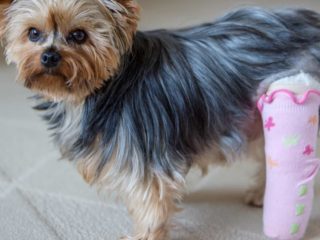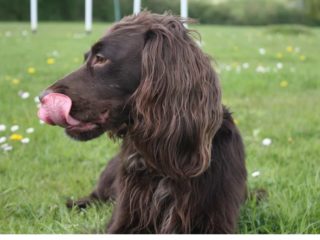A tail can tell us so much about our dog, they are a very beautiful and important trait on our lively Cocker Spaniel. But what is it about the tail that makes it so special? How do we know if our Cocker Spaniel has a normal tail, or if something may be off or different?
I was curious about this too so I took some time to Paws and Learn so I could find all the answers to every question you could have about your Cocker Spaniel tail. I’ve done my research and talked to a lot of Cocker Spaniel owners and vets so you can have all the answers in one place.
Do Cocker Spaniels have tails, what should they look like?
Cocker Spaniel naturally have long feathery tails, that when relaxed usually point straight out behind them. In countries where docking is allowed Cocker Spaniels will often have docked tail no longer than 4 inches, or a short stub tail depending on how short it was cut when docked.
Generally, Cocker Spaniel’s tails do not curl over their backs. It is possible but is considered a flaw in genetics. Most cocker Spaniel’s tails extend out behind them while working or relaxed. The tail may be pointed up when excited or extremely attentive or focussed. If your Cocker Spaniel has a short stub tail then it most likely has been docked.
How long are Cocker Spaniel tails?
Cocker Spaniel’s natural tails are on average are 8 to 12 inches long however it is not uncommon for Cocker Spaniel to have tails ranging from 3.5 inches all the way to 16 inches long. Cocker Spaniel who have docked tails will have tails ranging from 4 inches to 9 inches.
Do Cocker Spaniel get their tails docked?
Many Cocker Spaniels that are born in the US will have their tails docked between 2-5 days old. This has been the tradition to protect working dogs from tail injuries. It is also done to conform with the breed standards of the AKC. In recent years leaving a Cocker Spaniel tail un-docked has become more popular.
Docking tails is a highly controversial subject. You will find dog owners who will argue for both sides. Some owners love the long natural flowing tail of their Cocker Spaniel while others find it difficult to groom and care for.
Disclaimer: This post may contain affiliate links. We only recommend high-quality products that are used and recommended by real owners. If you use these links to buy something we earn a small commission.
Most Cocker Spaniel breeders will dock their litters’ tails before finding homes for or consulting with their pup’s future families.
A poll of Cocker Spaniel owners was taken to see their thoughts on tail docking. Here are the results.
Cocker Spaniel Owners surveyed from this Facebook Group.
Why Do they Cut (Dock) Cocker Spaniel Tails
Docking is a tradition that dates back to Roman times where they would dock a dog’s tail because they believed it prevented rabies. In the United stated the practice of docking tails for cosmetic reasons began in the 1950s. This was done to conform to the breed standards and be accepted into the AKC.
Cocker Spaniel tails were traditionally docked to prevent injuries while hunting and to stop them from wagging their tails in the long underbrush scaring away prey. It was also believed it helped to make the dog run faster.
Fun Fact: In the 18th century there was a tax imposed on all dogs unless they were working dogs. So naturally, people decided to cut all ‘Working dogs’ tails off to tell them apart from non-working dogs. And well, that led to owners cutting off their non-working dogs’ tails just to avoid getting taxed. See full article here.
Cocker Spaniels have such long fluffy tails that when they are working in the fields and underbrush while hunting there are many dangers that they might encounter as far as their tail is concerned. Working Cocker Spaniels will have their tails docked for these reasons.
- Long bushy tails get burs and stickers in them from being in the brush and fields often.
- Their tails are in danger of being stepped on by horses and other large animals.
- Their tails may easily get snagged in gaits fences or other things.
- They are overall more prone to injury which can cause the dog undue pain and may result in having to get its tail docked (amputated) as an adult which is much more painful to do than as a puppy.
Why do Breeders Cut (Dock) a Cocker Spaniel Tail
Breeders will dock Cocker Spaniels’ tails if they are following the AKC standard. In order to register their pups with the AKC as well as have them eligible to become show dogs, they have to follow the standard which is a docked tail.
Breeders may have an incentive to have their puppies registered with the AKC as it is a type of a status symbol and there are a number of benefits for the breeder to have their pups registered.
They not only get recognition for conforming to the breed standard, but they may also have an easier time finding a new home for their pups while getting top dollar.
Because they have to go through some rigorous genetic testing and health screenings, many buyers prefer to buy a puppy that is registered with the AKC in order to ensure that they are healthy and purebred.
Generally, a breeder that follows the AKC standard has been very careful to breed dogs that are healthy and free of genetic health problems.
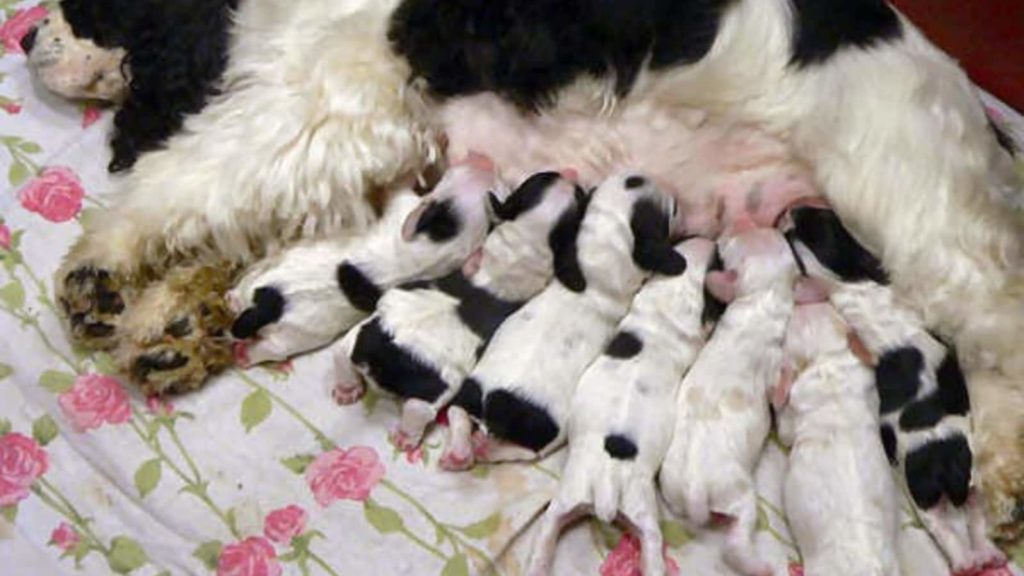
The Process of Docking a Cocker Spaniel Tail (When and How)
Cocker Spaniel tails are most often docked between 2-5 days old. There are 2 ways that the docking may be done. One is to make a surgical cut with special shears about 1 in below the base of the tail, the other is to band the tail in the same place and allow the remaining part to either be reabsorbed or to drop off on its own.
Either way, the docking should always be performed by a licensed vet in order to ensure that there are no complications such as infection or nerve damage.
Docking is done on puppies at such a young age because the cartilage is soft and the bones have not yet developed.
Dogs who are older than 8 weeks will have vertebrae in their tails that will need to be carefully cut around. Dogs this age and older will need to have anesthesia in order to avoid the sharp pain of the procedure.
What do Docked Tails Look Like on a Cocker Spaniel
Generally, a Cocker Spaniels tail is only docked one-quarter of its regular length, meaning they retain three-quarters of their natural tails. Some Cockers Spaniel tails will be docked shorter.
Their tails are generally a bit longer than most breeds with docked tails, but there is a range of short and stubby with only an inch or two or longer all the way up to 9 inches. Depending on the cut of the dog’s coat sometimes the docked tail blends and makes it look as though they have no tail at all.
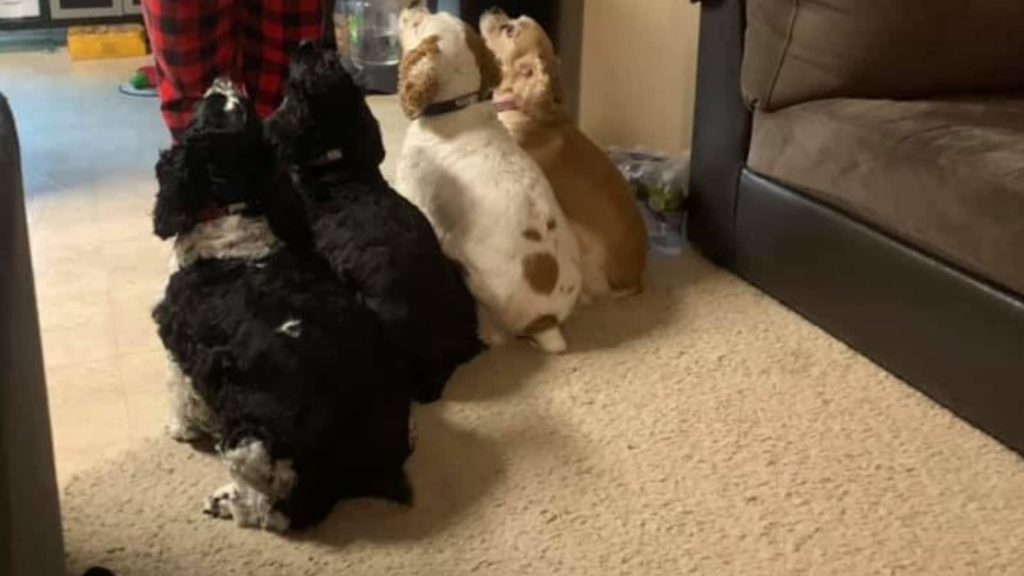
Cocker Spaniel Tail Styles and Grooming
There are a lot of fun and stylish cuts to choose from for your Cocker Spaniel tail grooming. Depending on how your Cocker Spaniel tail sits, how long it is and how much grooming you want to do on a weekly basis can help you determine which style or cut you would like. You may also want to think about the kinds of activities you do with your dog to help you decide which cut to do.
Flag Tail
How To Achieve the Look: This is a fun look that is named as such because it looks like the outline of a flag. The base of the tail and around the anus is cut short for the first 2-3 inches then the rest of the tail is trimmed into a rectangle shape.
Good For: Owners who like a nice neat look but still enjoy the beautiful natural look as well. This style needs to be brushed out at least once a week to keep mats from forming.
Plume Tail
How To Achieve the Look: This look is mostly left natural except that it is trimmed up a little around the anus and trimmed just enough to straighten up the edges, but not in a set rectangle shape like the flag style.
Good For: Owners that like a natural look but prefer to have it trimmed up just a bit to look more neat and tidy. This look needs to be brushed 2-3 times a week.
Long and Fluffy (all Natural)
How To Achieve the Look: Do nothing as far as trimming or cutting goes. This look is meant to be all-natural showcasing the original beauty of your gorgeous dog. You will need to spend some extra time brushing and keeping this tail mat and tangle-free.
Good For: Owners who love the all-natural look and long billowy tail of their Cocker Spaniel. It’s great for owners who don’t want to take their dogs to the groomers as often but requires at least 2-3 times a week of brushing if not daily in order to keep it free from mats and bugs.
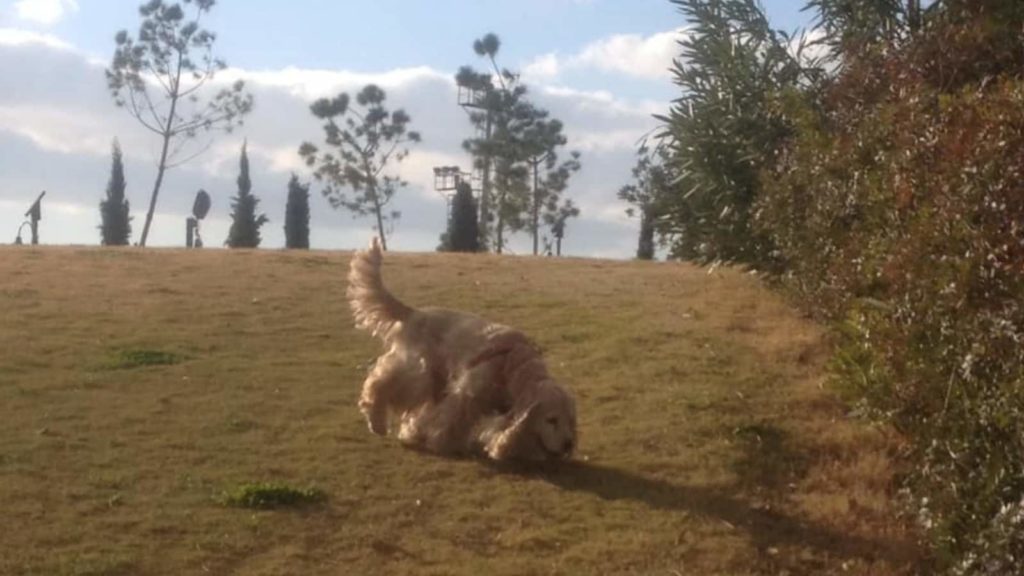
Bottle Brush
How To Achieve the Look: Neat and trimmed short in the same style as the rest of the body the hair can be anywhere from 2-4 inches long and is the same length through the entire tail.
Good For: Owners who are very active and don’t want the hair to get caught or pulled on anything. Also good for owners who don’t want to spend as much time brushing the tail out multiple times a week. It will still require brushing about once a week but should be quick and easy.
Pom Tail or Lion Style
How To Achieve the Look: Two–thirds of the tail, starting at the base, is trimmed closely, with a long plume of hair left at the end. If you arch the tail over the dog’s back, the spot where the tail begins to bend is approximately where the plume should begin.
Good For: This is a more traditional Poodle-type look. Owners I talked to also said that they prefer this style for easy grooming as there is less hair at the end of the tail to get tangled and less of a chance for the hair to get stepped on or stuck in something.
How to Groom A Cocker Spaniel Tail
Depending on the cut you choose for your Cocker Spaniel will determine how you cut it, but for a lot of owners part of the charm of having this beautiful breed is the gorgeous plume flowing from their rear end. This does require daily or at the least bi-weekly brushing.
If you plan on trimming or grooming your Cocker Spaniel hair yourself then it’s very important to have good high-quality tools to use. This scissor kit has worked great for me as I groom my own dog, it is a great place to start and can help you get the high-quality look you are going for.
Here is a great Video Overview on trimming a Cocker Spaniel docked tail.
Cocker Spaniel Tail Wagging and Communication
Cocker Spaniel wag their tails for many different reasons. It’s a big part of how they communicate with you. Wagging their tail doesn’t always mean they are happy. They could be conveying other emotions like nervousness or fear as well. The key to understanding their tail wags is to put it together with all the other contextual clues they are giving you. What are their ears doing, their eyes, how is their posture? Noticing these things as well will help you know why your Cocker Spaniel is wagging its tail.
Here are some things your Cocker Spaniel could be communicating to you with its tail.
- Calm and chill – Tail in the natural resting position. Sleeping or resting or casually walking around.
- Greeting or I love you – Usually, a big carefree wag, accompanied by eye contact, coming to you and jumping on you or trying to get your attention.
- Curious or unsure – Backwards and gentle wagging. Maybe sniffing around a little, intense and curious staring. Looking to you for reassurance.
- I’m nervous or scared – The tail between their legs and possibly slightly moving. Body tense, eyes down, ears laid back. Could also be trying to communicate a submissive position.
- Aggression – Tail high in the air and rigid. Poised, rigid, and making eye contact. Could be barking or growling as well.
- Happy and Excited – Fast care free wagging. Wiggling body, happy facial expressions. Body not tense, possibly going in circles around the object causing excitement such as a treat or toy.
There’s also been a study done that shows the direction that your dog wags its tail can show positive or negative emotion. Wagging their tail towards the right side of their body can indicate more positive emotions such as relaxed, and happy. Wagging their tails on the left side of their body is a sign of more negative emotions such as nervousness or fear.
For most Cocker Spaniel wagging their tails to communicate is a natural and normal thing for them to do. Occasionally you will find a Cocker Spaniel that doesn’t wag its tail at all. Don’t worry, you are not alone.
If your Cocker Spaniel doesn’t wag its tail it’s most likely just part of its personality or genes. It could also be that they have an extra curly or short tail that makes it more difficult for them to wag, but it could also indicate a medical problem and they should be seen by your vet to rule out any serious issues.
If your Cocker Spaniel has recently stopped wagging its tail then there are some other things you should consider. If you have just moved, or they are new to your home this could just mean they are nervous and need some time to get acclimated to their new environment.
Some dogs are bigger tail-waggers than others. If your Cocker Spaniel doesn’t wag its tail at all then you will have to learn to identify other body language cues to help you understand what they are trying to tell you.
Other Tips for Cocker Spaniel Tail Problems
What is Limber (Swimmers) Tail and What to Do
If you notice your Cocker Spaniel tail hanging down and it looks limp and unnatural then he may have a condition known as Limber Tail.
Limber tail Also known as swimmer’s tail, frozen tail, dead tail, broken wag, or cold tail is a condition that causes your dog to hold his tail limp and down instead of the usual upright position. Its official name is Acute Caudal Myopathy.
It is most likely to happen after your dog has had a very active or strenuous play, exercise, or excessive tail wagging. Sometimes a lot of swimming can cause it, being in cold wet weather, if they are confined to their crate too long, or if your doodles tail is wagging and getting whacked on various surfaces.
This could cause your dog pain and swelling in their tail, making it difficult to sit. Usually, this condition will go away on its own after a few days of rest. It’s important to try and limit exercise and movement if you notice that your dog is experiencing this problem. If it is causing your doodle a lot of pain then consulting your vet is a good idea.
Usually, this isn’t a chronic problem, but it is a good idea to figure out what may have triggered it in the first place and try to avoid that activity if possible. Coldwater play, or being confined in a crate too long are often things that could trigger this condition.
If your Cocker Spaniel is also limping this article will be helpful to read as well. Why is My Cocker Spaniel Limping?

Cocker Spaniel Licking Chasing or Biting Tail
If your dog is chasing, licking, or biting his tail it could be a simple game, or there could be something more going on. Chasing and biting could be an indication of fleas or mites, licking could indicate allergies.
To learn more about Cocker Spaniel licking read this: Cocker Spaniel Obsessive Licking (Quick Solutions Guide)
How to Keep Poop From Sticking to your Cocker Spaniel Butt
This can be a common smelly problem for long hair dogs. If it happens often and doesn’t get taken care of it can also lead to serious health issues as well.
Here are some tips to keep your fur baby’s fluffy rear end clean.
- Keep the hair near their rear clean and trimmed.
- Keep wipes handy to clean it out right away.
- Add more fiber to your dog’s diet.
- Check for infections or parasites such as worms.
Next Steps
Next up here are some other great articles to help you learn even more about your Cocker Spaniel and how to care for him/her.


